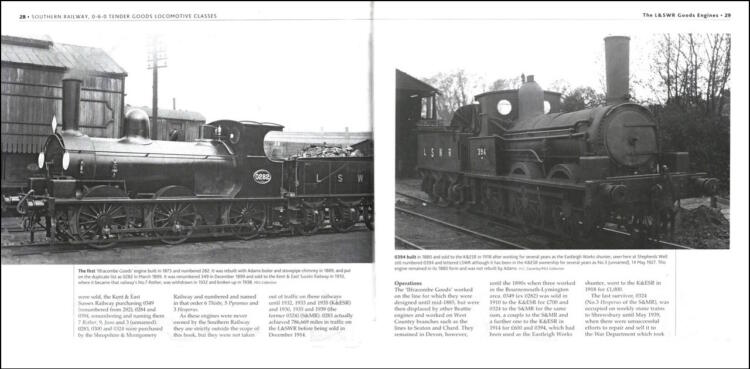Published in February 2021 as part of Pen & Sword's “Locomotive Profiles” series, this book provides a description of the 0-6-0 tender goods locomotives of the Southern Railway, including the steam locomotives taken over at the railway grouping in 1923, and the Q and Q1 classes built by the Southern Railway.
This hardback book is written by David Maidment and presented in landscape format, and measures around 25.14 cm x 24.13 cm, has 272 pages, and 250 colour & black and white illustrations and weight diagrams. It has a published price of £30, and at the time of writing it can be obtained from Amazon for £21.75
The Southern Railway inherited a number of 0-6-0 tender engines from its three former constituent companies, many of which lasted until the early 1960s. All of these are included, as well as the older Victorian and Edwardian classes of locomotive taken over that did not last very long with the new company. With five chapters this book provides an excellent overview of both the locomotives built by the Southern Railway's constituent companies before the Grouping and by the Southern Railway itself.
Chapter 1 gives a brief biography of each engineer who designed the locomotives covered by this book, the next three chapters describe all 0-6-0 tender engines built by the London & South Western Railway, the London, Brighton & South Coast Railway, and the South Eastern and Chatham Rail. Chapter five describes the two classes built by the Southern Railway – Maunsell's Q Class and Bulleid's Q1 Class.
Each chapter follows the same format, with construction details, technical information, operational history, allocations of each company's locomotives, many photographs of each class, and allocations from when they were built to their withdrawal.
An extensive appendix provides outline weight diagrams, dimensions, and technical details for each class covered by the book, and includes the original railway's running numbers, their later Southern Railway numbers, build and withdrawal dates, and first and final depot allocations.
The Index deserves a mention as it also includes a numerical list detailing page numbers for all locomotives illustrated in the book.
The photographs below illustrate locomotives of the former London and South Western Railway (LSWR), still in their original livery. Both of these locomotives were later sold to the Kent & East Sussex Railway.

Below are members of the London, Brighton and South Coast Railway's (LB&SCR) C2 Class with the ones on the left in their original livery. The photos on the right show some members of the class that were later rebuilt with a larger diameter boiler and an extended smokebox and were reclassified as C2X. They are immediately recognisable from the remainder of the class as they had two domes.
The photographs below show three examples of Henry Wainwright's extensive C Class built for the South Eastern and Chatham Railway (SE&CR). The list on the left-hand page shows that 54 of these were still at work in 1960. The list also shows that, like many locomotives on the Southern Railway, there was no great attempt to group members of the same class into some sort of numerical order.
Some consider the Q1 Class seen below, designed by Bulleid for the Southern Railway, to be among the ugliest locomotives ever to run on Britain's railways. However, their unusual look was a result of wartime constraints when ease of maintenance was the main criterion. Also, their lack of good looks did not preclude their occasional use on passenger traffic as well as freight.
Confirming the longevity of some South Eastern and Chatham Railway locomotives, the examples seen below were photographed just a few years before the end of steam on the Southern Railway.
The illustrations below show how useful this book would be to rail modellers, with extensive details of the locomotives' dimensions, loading weights, and other technical data. On the left-hand page is an example of the statistics presented for each class, with the date of build for each locomotive, when they were renumbered, their first and last allocated depots, and dates of withdrawal.
The book is available to purchase from Amazon and from Pen & Sword.
We would like to thank Pen & Sword for providing RailAdvent with a copy of the book for review.